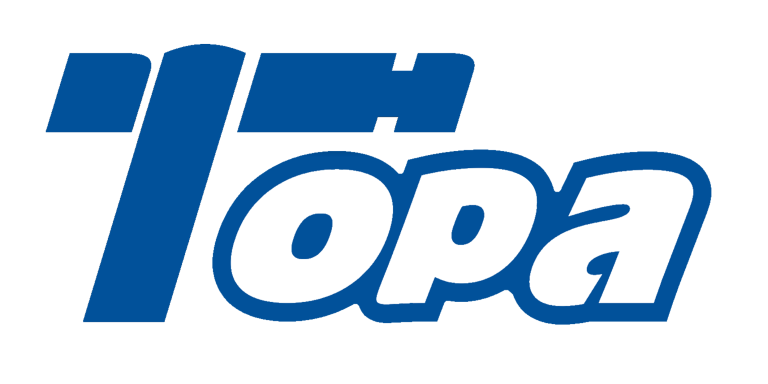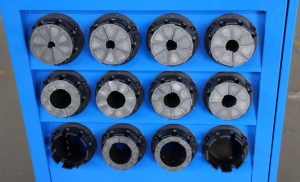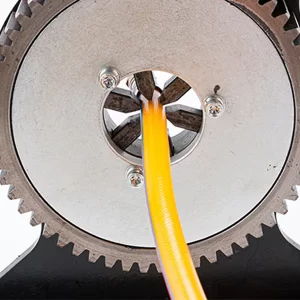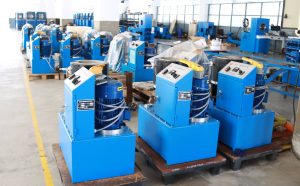When selecting a hydraulic hose crimper for your business, understanding the critical features that influence the efficiency and safety of the machine is paramount. The hydraulic hose crimper is an essential tool for industries that rely on secure hydraulic connections. Its primary purpose is to attach fittings to hydraulic hoses, ensuring that the system operates under optimal conditions. In this article, we will explore the top features B2B buyers should prioritize when purchasing a hydraulic hose crimper, ensuring your investment enhances productivity, reduces downtime, and improves overall safety.
1. What Are the Most Important Features for B2B Buyers in a Hydraulic Hose Crimper?
When purchasing a hydraulic hose crimper, it’s essential to focus on the features that will offer the best long-term value for your business. Ready for the good part? Here are the most crucial features you need to consider when selecting a crimper for your operations:
The crimping capacity is one of the most important factors to evaluate. This refers to the size and range of hoses the crimper can handle. The higher the crimping capacity, the more versatile the machine is. For example, a crimper that can handle hoses of varying diameters and materials will allow your business to meet diverse needs.
Durability is another critical feature. A hydraulic hose crimper needs to withstand constant use without breaking down. Materials like steel or heavy-duty aluminum offer increased longevity and reduce the need for frequent repairs.
Precision is also essential for creating secure, leak-proof connections. A high-quality crimper with precision control will ensure that your hydraulic systems are always running at peak efficiency.
Lastly, safety features such as emergency stop buttons, overload protection, and automatic shutoff mechanisms should never be overlooked. These features protect your workers and machinery from potential failures.
| Feature | Importance | Recommended Range |
|---|---|---|
| Crimping Capacity | Ability to handle various hose sizes | From 1/4 inch to 2 inches |
| Durability | Longevity and fewer breakdowns | Steel, aluminum, or stainless steel |
| Precision | Ensures tight, leak-free crimps | +/- 0.1mm tolerance |
| Safety Features | Protects workers and machinery | Emergency stop, overload protection |
2. How Does Crimping Capacity Affect Your Purchase Decision?
The crimping capacity of a hydraulic hose crimper determines the size of hoses and fittings the machine can handle. What’s the real story? If the crimper’s capacity doesn’t match the hoses you’re working with, you could end up with incomplete crimps or system failures, causing costly downtime.
Crimping capacity is a measure of the largest diameter hose that the crimper can securely crimp. If your business needs to work with a variety of hose sizes, you’ll want a machine with a broader crimping range. Hydraulic hose crimpers with higher crimping capacities are ideal for businesses that deal with larger or more complex hoses regularly.
For example, a crimper with a maximum capacity of 2 inches would be necessary for industries like construction, where larger hoses are the norm. Here’s the kicker: the right crimping capacity ensures that the crimper can handle all your operational needs, improving efficiency and ensuring safe, secure connections.
| Crimping Size | Max Hose Diameter | Best Use |
|---|---|---|
| 1/4 inch to 1 inch | Small to medium hoses | General-purpose industries |
| 1 inch to 2 inches | Medium to large hoses | Heavy machinery, construction |
| Over 2 inches | Large hoses | Specialized industries |
3. What Role Does Durability Play in Hydraulic Hose Crimpers?
Durability is an essential feature for hydraulic hose crimpers. This is where it gets interesting… Crimpers used in high-demand industrial environments need to withstand continuous usage without compromising performance.
Hydraulic hose crimpers are exposed to heavy loads and harsh working conditions. Over time, this can lead to wear and tear on the machine components. Choosing a crimper built from high-quality materials, such as steel or aluminum, ensures that the crimper can handle tough conditions without frequent repairs or breakdowns.
Durable crimpers reduce long-term maintenance costs, making them more cost-effective in the long run. Furthermore, a durable machine will continue to perform at its best, providing consistent results and reducing downtime. Ready for the good part? With the right materials and construction, a durable crimper will deliver better value, improving both safety and performance over time.
| Material | Durability Rating | Suitable Applications |
|---|---|---|
| Steel | High | Heavy-duty industrial use |
| Aluminum | Moderate to High | Medium-duty operations |
| Stainless Steel | Very High | Corrosive environments |
4. How Does Precision and Accuracy Influence Hydraulic Hose Crimpers?
Precision is key to achieving a secure and tight crimp on hydraulic hoses. But here’s the kicker: even small inaccuracies in crimping can lead to leaks, system failures, or equipment damage.
A hydraulic hose crimper that offers precise control will ensure that each crimp is consistent and leak-free, which is crucial for maintaining the efficiency and safety of the entire hydraulic system. The precision in crimping directly affects the integrity of the hydraulic connection. For instance, a hose that isn’t properly crimped can cause hydraulic fluid to leak, potentially leading to system malfunctions and costly repairs.
Precision crimpers allow operators to adjust settings to match the specific hose and fitting requirements, making them ideal for businesses that handle a variety of materials and hose sizes. What’s the real story? With a precise crimper, your hydraulic systems will perform optimally, reducing the risk of errors and improving system reliability.
| Precision Feature | Benefit | Example |
|---|---|---|
| Adjustable Pressure | Ensures correct crimping force | Different hose materials |
| Digital Measurement | Provides accuracy in crimp size | Ideal for high-precision work |
| Fine-Tuned Control | Ensures consistent results | Prevents leaks and failures |
5. What Safety Features Should B2B Buyers Look for in a Crimper?
Safety should always be a top priority when selecting hydraulic hose crimpers. What’s the real story? Hydraulic hose crimping involves high-pressure systems, and any failure in the process can result in dangerous accidents or damage to both the machine and the operator.
Key safety features that every crimper should have include automatic shutoff mechanisms, overload protection, and emergency stop buttons. These features ensure that if something goes wrong during the crimping process, the machine will stop immediately to prevent further damage or harm. Crimpers with built-in pressure relief valves also help prevent accidents related to excessive pressure.
A crimper with these safety features can help ensure that the workplace remains safe for operators while also minimizing the risk of damage to equipment. Ready for the good part? Choosing a crimper with robust safety features will protect both your workers and your investment.
| Safety Feature | Purpose | Example |
|---|---|---|
| Emergency Stop Button | Stops machine in case of danger | Protects workers from harm |
| Overload Protection | Prevents damage to the machine | Maintains crimping pressure |
| Automatic Shutoff | Prevents continued crimping during faults | Reduces the risk of failures |
6. Why Should Automation Be Considered in Hydraulic Hose Crimpers?
Automated hydraulic hose crimpers offer numerous benefits, especially in high-volume operations. This is where it gets interesting: automation increases speed, reduces the risk of human error, and improves the consistency of crimps.
Automated crimpers can be programmed to adjust pressure, crimp time, and other parameters, ensuring that each crimp meets the exact specifications needed. These machines can also handle a larger volume of work, which is a game-changer for businesses that need to produce large quantities of hoses quickly. What’s the real story? Automation in crimpers helps businesses scale operations efficiently, allowing them to focus more on production and less on manual adjustments.
For businesses that work with a wide range of hose sizes and materials, automated crimpers offer flexibility and precision that manual crimpers cannot match. But here’s the kicker: while they may come with a higher upfront cost, the long-term savings in labor and improved productivity make automated crimpers a worthwhile investment.
| Feature | Manual Crimpers | Automated Crimpers |
|---|---|---|
| Speed | Slower, labor-intensive | Fast, efficient operation |
| Consistency | Depends on operator skill | Consistent, uniform crimps |
| Labor Requirements | Requires more operator involvement | Minimal human intervention |
7. How Do Compatibility and Versatility Affect the Decision to Buy?
Crimper compatibility and versatility are key factors when choosing a hydraulic hose crimper. What’s the real story? A versatile crimper allows you to handle various types of hoses, materials, and fittings, making it suitable for a broader range of applications.
Compatibility is crucial, especially for businesses that work with different types of fittings or hoses. A crimper that is not compatible with the required fittings will reduce operational efficiency and increase the risk of errors. For example, a crimper that works with only one type of fitting may not be suitable for businesses that need to work with multiple fitting sizes and materials.
Here’s the kicker: choosing a crimper that offers the flexibility to handle various hoses and materials will save your business time, reduce costs, and improve overall productivity.
| Compatibility Feature | Benefits | Example |
|---|---|---|
| Adjustable Dies | Allows for different hose sizes | Flexibility in applications |
| Multiple Hose Types | Works with various hose materials | Rubber, PVC, stainless steel |
| Versatile Fittings | Handles different fitting types | Industrial and commercial hoses |
8. What Are the Operational Costs of Using a Hydraulic Hose Crimper?
Operational costs are an important consideration when purchasing a hydraulic hose crimper. Ready for the good part? While the upfront cost of a crimper may be high, understanding the operational costs can help you make an informed decision that benefits your business in the long run.
Operational costs include energy consumption, maintenance, and repair costs. Hydraulic hose crimpers with energy-efficient motors can help reduce electricity costs, while crimpers made of durable materials tend to have lower maintenance costs over time. Regular maintenance, such as cleaning, lubrication, and die replacement, can also extend the lifespan of the crimper, reducing overall costs.
What’s the real story? Investing in a high-quality, efficient crimper can save money in the long run by reducing operational and repair costs.
| Cost Factor | Estimated Expense | Solution |
|---|---|---|
| Energy Consumption | Varies by machine size | Choose energy-efficient models |
| Maintenance | Replacement parts, labor | Regular inspection and upkeep |
| Repair Costs | Occasional component failure | Invest in durable, high-quality models |
9. How Does Hydraulic Pressure Impact Crimping Quality?
Hydraulic pressure plays a crucial role in achieving high-quality crimps. This is where it gets interesting: the pressure applied during crimping affects how tightly the fitting is attached to the hose, ensuring a secure and leak-free connection.
Too much pressure can cause the hose to collapse, while too little pressure will result in an incomplete crimp. Crimpers with adjustable pressure settings allow operators to fine-tune the pressure for different hose types and materials. Ready for the good part? A crimper with precise hydraulic pressure control helps ensure that each crimp is perfect, reducing the risk of leaks and system failures.
| Pressure Setting | Impact on Crimping | Best Use |
|---|---|---|
| Low Pressure | Soft crimps, weak seal | Delicate hoses and materials |
| Medium Pressure | Standard crimps | General industrial use |
| High Pressure | Strong, tight seal | Heavy-duty hydraulic systems |
10. What Maintenance Is Required for a Hydraulic Hose Crimper?
Maintaining your hydraulic hose crimper is essential for ensuring long-term performance and avoiding costly repairs. What’s the real story? Regular maintenance can prevent breakdowns, improve efficiency, and extend the machine’s lifespan.
Key maintenance tasks include cleaning the crimper after use, lubricating moving parts, and inspecting hydraulic seals for wear. Here’s the kicker: replacing worn-out components, such as dies and seals, will help the crimper continue to operate at peak performance, reducing downtime and ensuring that crimps remain tight and secure.
| Maintenance Task | Frequency | Benefit |
|---|---|---|
| Cleaning | After every use | Prevents buildup and clogs |
| Lubrication | Monthly or as needed | Reduces wear on moving parts |
| Die Replacement | Every 6-12 months | Ensures consistent crimps |
FAQ Section
Q1: What is a hydraulic hose crimper?
A hydraulic hose crimper is a machine used to attach fittings to hydraulic hoses, ensuring a secure, leak-free connection.
Q2: How does a hydraulic hose crimper work?
A hydraulic hose crimper uses hydraulic pressure to press a fitting tightly onto a hose, creating a secure and leak-proof bond.
Q3: What are the most important features to consider when choosing a hydraulic hose crimper?
The most important features include crimping capacity, durability, precision, safety features, and ease of maintenance.
Q4: Why is safety a key feature in hydraulic hose crimpers?
Safety features such as automatic shutoff and overload protection help prevent accidents during operation, ensuring both worker and equipment safety.
Q5: How can I maintain my hydraulic hose crimper?
To maintain a hydraulic hose crimper, clean it regularly, lubricate moving parts, and inspect for wear and tear. Replace any worn-out components as needed.




